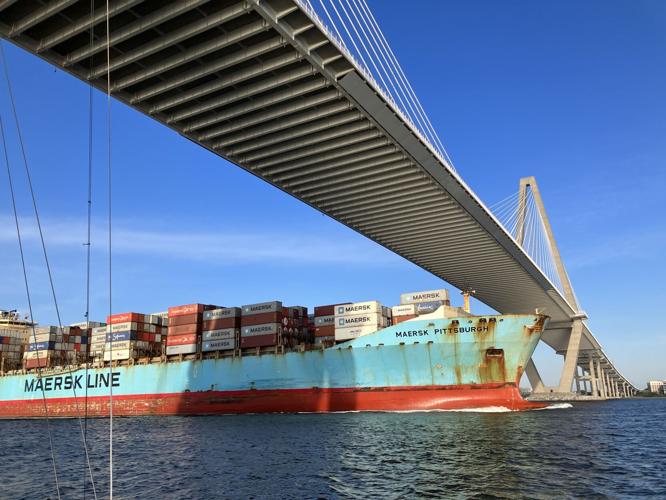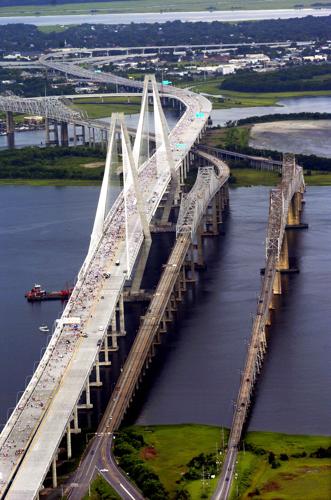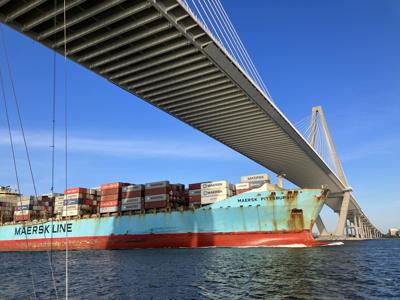It has happened here.
In 1946, a freighter called the Nicaragua Victory smashed into the old Grace Memorial Bridge, taking out a 240-foot chunk of roadway. One vehicle containing the Lawson family plunged into the harbor. All five passengers died.
The old steel truss bridge, which had opened to traffic in the early 1930s, was out of commission for six months.
Commercial shipping ports like Charleston Harbor can be tricky to navigate under certain circumstances, and big ships are driven by imperfect human beings. To account for the hazards and risks, engineers today design bridges capable of withstanding collisions, as well as the impacts of hurricanes and earthquakes.
The March 26 disaster in Baltimore shows that older infrastructure is particularly vulnerable.
At about 1:30 a.m., a large cargo ship leaving the Port of Baltimore lost power — and steerage — ramming into a structural pillar of the Francis Scott Key Bridge and causing a large portion of the span to collapse. The steel bridge was built in the 1970s and was part of Interstate 695, which encircles the city.
The incident is a reminder of the perils of marine navigation and the fallibility of both structural design and human expertise.

A container ship approaches the Arthur Ravenel Jr. Bridge, heading to sea from the Wando Terminal.
The Arthur Ravenel Jr. Bridge connecting Charleston and Mount Pleasant is a good example of a modern design meant to tolerate adversity. And recent upgrades to Charleston Harbor make things safer and easier for commercial mariners.
Those navigators get special local assistance, as well. Charleston Harbor pilots board these enormous vessels to guide them in and out of port, and tugboat operators help maneuver the ships, pushing them on and off the dock, and orienting them properly in the shipping channel.
Navigation aids, such as channel markers and government buoys, also assist boat operators inside the harbor and in the shipping channel offshore.
Despite all these precautions, safety measures and assistance both technical and human, accidents can happen. That’s why the Ravenel Bridge design includes large rock piles at the base of the two 575-foot towers.
Those rocks — 1.6 million tons of them imported from Canada — extend high enough (12 feet above the waterline) and far enough from the base of the towers to provide an essential buffer against ships gone astray. The rock islands are one acre each, or 43,560 square feet. Built pyramid-shaped, they nearly reach the outer edges of the channel at the bottom.
A ship that veered off course and outside the channel would run aground before striking the towers. The design ensures that a vessel as large as a modern aircraft carrier can plow into the rocks and the bridge will remain standing.
Consider it a case of learning from human mistakes.
Charleston’s spans
The Baltimore bridge’s collapse shouldn’t send Charleston residents into a panic, said Jesus M. de la Garza, director of the Clemson University School of Civil and Environmental Engineering and Earth Sciences.
“This could be just a freak situation,” he said. “We need to wait to determine what was the reason the ship ran into that pier.”

The Arthur Ravenel Jr. Bridge, opened to foot and wheelchair traffic on July 9, 2005, in Charleston. The old Grace and Pearman bridges were not yet removed.
An investigation into that bridge’s collapse could indicate whether engineers should take a closer look at Charleston’s structures, he added.
Engineers keep tabs on the state’s spans. The state Department of Transportation inspected the Ravenel Bridge last July, DOT chief bridge engineer Rob Perry told The Post and Courier. It earned straight sevens — a “good” rating.
“While it’s been around for 19 years now, it’s in good condition,” Perry said.
The Don Holt Bridge was checked in January and determined to be in good operating condition, a DOT spokesperson said.
DOT, South Carolina Ports and the Charleston Branch Pilots Association have discussed the Baltimore crash and plan to review Charleston’s harbor operations, procedures and state infrastructure, their leaders said in a joint statement.
DOT inspects bridges every two years, per guidelines from the Federal Highway Administration. No major ship collisions have imperiled the Ravenel Bridge. But that can’t be said for structures across the country.
In 1980, a rogue freighter, the 20,000-ton Summit Venture, crashed into the base of a tower holding up the Sunshine Skyway Bridge in Tampa Bay, Fla. The Skyway Bridge, another steel truss design, consisted of two distinct roadway structures with a significant gap between them. One side came crashing down, along with six cars, a truck and a Greyhound bus. Thirty-five people were killed.
Lessons
Such disasters become essential case studies for bridge engineers. The Skyway collapse has informed designers ever since, and can be cited as a reason for the rock islands at the base of the Ravenel Bridge.
Collision wasn’t the only threat our bridge engineers needed to consider. They faced two other major challenges: the potential for an earthquake and the inevitability of a major hurricane.
The Ravenel Bridge was designed to withstand 300 mph winds (stronger than a Category 5 storm) and a tremor that registers 7.3 on the earthquake scale.
But here’s the thing: For a bridge to tolerate an earthquake, it must be flexible; for it to manage a hurricane, it must be rigid. Engineers working on the Ravenel Bridge needed to strike just the right balance.
Part of the solution was to drive rebar cages 230 feet into the clay beneath the harbor waters, a depth that would provide the stability necessary to keep those towers rigid. The cable-stayed design allows for some roadway movement, providing the flexibility needed in case the Dorchester Fault decides to rupture hard.
And the “ship collision pier protection” — those rocks at the base of the towers — keeps the big ships off.
Designers used computer models to simulate hurricanes and boat collisions in an effort to foresee, and forestall, the dangers. They calculated that the bridge would remain intact even if a few of the thick cables gave way.

A container ship passes under the Arthur Ravenel Jr. Bridge on May 29, 2023.
The fixed safeguards might be adequate to keep the Ravenel upright, but for added protections, the commercial port requires a Charleston harbor pilot to stand at the helm of every large vessel, including military and cruise ships, as they enter and exit the harbor. And tug boats float patiently just south of the bridge, waiting for the big ships to arrive, then guide them to the docks.
The commercial vessels have a restricted ability to maneuver, meaning they can’t turn fast, and they must remain within the designated shipping channel. That gives them the right of way. The channel, delineated by red and green buoys, is wide enough for two large ships to pass each other, and deep enough now to accommodate the new generation of gigantic container ships which, when fully loaded, can extend 40 or 50 feet down into the water.
Charleston’s channel is 54 feet deep at low tide, 52 feet beneath the bridge — the result of a multiyear dredging project that finished in 2022. It’s the deepest channel on the East Coast. The distance from the water to the roadway of the Ravenel Bridge is nearly 200 feet.
Improvement
On March 26, the state Department of Transportation announced it was replacing the Don Holt Bridge, which spans the Cooper River connecting North Charleston and Daniel Island.
The Don Holt Bridge, like the Baltimore span and Charleston’s old Pearman and Grace bridges, is a steel-truss design. Armin Mehrabi, an engineering professor at Florida International University, called truss bridges elegant and adequate. But like most structures that span water, they’re susceptible to corrosion. Proper inspections and maintenance can manage wear and tear.
The new Don Holt Bridge is likely to include safety features akin to the Ravenel Bridge, according to DOT.
“The Don Holt bridge already has some protective measures that surround the bridge designed for the type of cargo traffic that is currently traveling that channel,” the statement reads. “We would expect that as we move to replace the Don Holt in the near future we would adopt similar safety measures to what is in place on the Ravenel. We anticipate this will be a larger, higher structure that will be in alignment with Ravenel and support the continued growth of our Port.”
As the Francis Scott Key Bridge is cleared from the mouth of Baltimore Harbor, shipping traffic will be diverted to other ports, possibly including Charleston.
Gov. Henry McMaster, after consulting with the State Ports Authority, said Charleston was among the top destinations for rerouted cargo traffic, and that South Carolinians could expect to see elevated truck and ship traffic for the next several months as a result of the disaster.
















